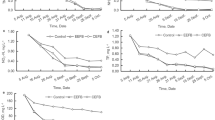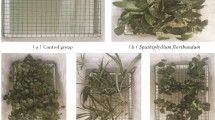Abstract
A novel floating-bed incorporated with water spinach (Ipomoea aquatica), Asiatic clam (Corbicula fluminea), and carrier media supported biofilm was developed for eutrophic water purification. The contributions of each biologic component to the removals of total nitrogen (TN), total phosphorus (TP) and Chl.a were examined. The nutrient removals due to the direct uptake by either water spinach or Asiatic clam were less than 10%, suggesting a negligible role of biologic assimilation and leaving the biofilm as the indispensable biologic component in the floating-bed. Chl.a was reduced mainly by Asiatic clams via filter-feeding. Meanwhile, the digestion and excretion of Asiatic clams benefited the proliferation of nitrifying and denitrifying bacteria, resulting in the improvement of TN removal. In summary, the synergetic effects of water spinach, Asiatic clams and biofilms would promote the eutrophic water treatment performance of floating-bed in comparison with the conventional floating-bed with vegetation as the single biologic component.
Similar content being viewed by others
References
Chen M, Chen J, Du P. An inventory analysis of rural pollution loads in China.Water Science and Technology, 2006, 54(11): 65–74
Chen M, Chen J, Sun F. Agricultural phosphorus flow and its environmental impacts in China. Science of Total Environment, 2008, 405(1–3): 140–152
Reddy K R, Fisher MM, Ivanoff D. Resuspension and diffusive flux of nitrogen and phosphorus in a hypereutrophic lake. Journal of Environmental Quality, 1996, 25(2): 363–371
Hubbard R K, Gascho G J, Newton G L. Use of floating vegetation to remove nutrients from swine lagoon wastewater. Transactions of the ASAE, 2004, 47(6): 1963–1972
Garbett P. An investigation into the application of floating reed bed and barley straw techniques for the remediation of eutrophic waters. Water and Environment Journal, 2005, 19(3): 174–180
Li M, Wu Y J, Yu Z L, Sheng G P, Yu H Q. Nitrogen removal from eutrophic water by floating-bed-grown water spinach (Ipomoea aquatica Forsk.) with ion implantation. Water Research, 2007, 41(14): 3152–3158
Li M, Wu Y J, Yu Z L, Sheng G P, Yu H Q. Enhanced nitrogen and phosphorus removal from eutrophic lake water by Ipomoea aquatica with low-energy ion implantation. Water Research, 2009, 43(5): 1247–1256
Sun L, Liu Y, Jin H. Nitrogen removal from polluted river by enhanced floating-bed grown canna. Ecological Engineering, 2009, 35(1): 135–140
Hooper D U, Chapin F S, Ewel J J, Hector A, Inchausti P, Lavorel S, Lawton J H, Lodge D M, Loreau M, Naeem S, Schmid B, Setälä H, Symstad A J, Vandermeer J, Wardle D A. Effects of biodiversity on ecosystem functioning: a consensus of current knowledge. Ecological Monographs, 2005, 75(1): 3–35
Li X N, Song H L, Li W, Lu X W, Nishimura O. An integrated ecological floating-bed employing plant, freshwater clam and biofilm carrier for purification of eutrophic water. Ecological Engineering, 2010, 36(4): 382–390
Song H L, Li X N, Lu XW, Inamori Y. Investigation of microcystin removal from eutrophic surface water by aquatic vegetable bed. Ecological Engineering, 2009, 35(11): 1589–1598
Hakenkamp C C, Ribblett S G, Palmer M A, Swan C M, Reid J W, Goodison M R. The impact of an introduced bivalve (Corbicula fluminea) on the benthos of a sandy stream. Freshwater Biology, 2001, 46(4): 491–501
Duan H T, Ma R H, Xu X F, Kong F X, Zhang S X, Kong W J, Hao J Y, Shang L L. Two-decade reconstruction of algal blooms in China’s Lake Taihu. Environmental Science and Technology, 2009, 43(10): 3522–3528
Guo L. Ecology-Doing battle with the green monster of Taihu Lake. Science, 2007, 317(5842): 1166
Editorial Board of Monitoring and Analytical Method of Water and Wastewater, State Environmental Protection Administration of China. Monitoring and Analytical Method of Water and Wastewater, 4th ed. Beijing: China Environmental Science Press, 2002
Findlay R H, King G M, Watling L. Efficacy of phospholipid analysis in determining microbial biomass in sediments. Applied and Environmental Microbiology, 1989, 55(11): 2888–2893
Amann R I, Ludwig W, Schleifer K H. Phylogenetic identification and in situ detection of individual microbial cells without cultivation. Microbiol. Rev., 1995, 59(1): 143–169
Alexander M. Most probable number method for microbial populations. In: Page A L eds. Methods of Soil Analysis, Part 2, 2nd ed. Madison: WI, 1982, 815–820
Awong J, Bitton G, Koopman B. ATP, oxygen-uptake rate and INT-dehydrogenase activity of actinomycete foams. Water Research, 1985, 19(7): 917–921
Lauritsen D D. Filter-feeding in Corbicula fluminea and its effect on seston removal. Journal of the North American Benthological Society, 1986, 5(3): 165–172
Ji R P, Lu X W, Li X N, Pu Y P. Biological degradation of algae and microcystins by microbial enrichment on artificial media. Ecological Engineering, 2009, 35(11): 1584–1588
Madsen J D, Hartleb C F, Boylen C W. Photosynthetic characteristics of Myriophyllum spicatum and 6 submersed aquatic macrophyte species native to Lake George, New York. Freshwater Biology, 1991, 26(2): 233–240
Ghermandi A, Vandenberghe V, Benedetti L, Bauwens W, Vanrolleghem P A. Model-based assessment of shading effect by riparian vegetation on river water quality. Ecological Engineering, 2009, 35(1): 92–104
Chen X, He S, Huang Y, Kong H, Lin Y, Li C, Zeng G. Laboratory investigation of reducing two algae from eutrophic water treated with light-shading plus aeration. Chemosphere, 2009, 76(9): 1303–1307
Turner J T, Graneli E. Zooplankton feeding ecology: grazing during enclosure studies of phytoplankton blooms from the west coast of Sweden. Journal of Experimental Marine Biology and Ecology, 1992, 157(1): 19–31
Newell R I E. Ecosystem influences of natural and cultivated populations of suspension-feeding bivalve molluscs: a review. Journal of Shellfish Research, 2004, 23(1): 51–61
Boltovskoy D, Izaguirre I, Correa N. Feeding selectivity of Corbicula fluminea (Bivalvia) on natural phytoplankton. Hydrobiologia, 1995, 312(3): 171–182
Elliott P, Aldridge D C, Moggridge G D. Zebra mussel filtration and its potential uses in industrial water treatment. Water Research, 2008, 42(6–7): 1664–1674
Vaughn C C, Hakenkamp C C. The functional role of burrowing bivalves in freshwater ecosystems. Freshwater Biology, 2001, 46 (11): 1431–1446
Nelson K A, Leonard L A, Posey M H, Alphin T D, Mallin M A. Using transplanted oyster (Crassostrea virginica) beds to improve water quality in small tidal creeks: a pilot study. Journal of Experimental Marine Biology and Ecology, 2004, 298(2): 347–368
Author information
Authors and Affiliations
Corresponding author
Rights and permissions
About this article
Cite this article
Song, H., Li, X., Li, W. et al. Role of biologic components in a novel floating-bed combining Ipomoea aquatic, Corbicula fluminea and biofilm carrier media. Front. Environ. Sci. Eng. 8, 215–225 (2014). https://doi.org/10.1007/s11783-013-0587-z
Received:
Accepted:
Published:
Issue Date:
DOI: https://doi.org/10.1007/s11783-013-0587-z




